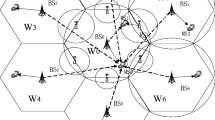Abstract
In Orthogonal frequency division multiple access (OFDMA) cellular system, the user at the different location of the cell requires different number of subcarriers to satisfy the user’s data rate requirement. In this paper, based on the Interference to Signal Ratio (ISR), we analyze the average number of downlink subcarriers required at inner and outer region for the two-hop OFDMA cellular system. Firstly we propose a two-hop OFDMA cellular system model. Then based on this model, we calculate the Cumulative Distribution Function of ISR at inner and outer region respectively, and obtain the theoretical analysis results for the average number of subcarriers required at two regions of the reference cell. Finally, with the help of the numerical calculation and Monte-Carlo simulations, we analyze the impact of the various parameters on the average number of subcarriers required of the two-hop cellular system. And the results are compared with the average number of subcarriers required of the one-hop cellular system.








Similar content being viewed by others
References
Sagong, M., & Cheun, K. (2012). A statistical inter-cell interference model for uplink cellular OFDMA networks under log-normal shadowing and Rayleigh Fading. IEEE Communications Letters, 16(6), 824–827.
Seol, C., & Cheun, K. (2009). A statistical inter-cell interference model for downlink cellular OFDMA networks under log-normal shadowing and multipath Rayleigh fading. IEEE Transactions on Communications, 57(10), 3069–3077.
He, J., Tang, Z., Chen, H. H., et al. (2013). Statistical model of OFDMA cellular networks uplink interference using lognormal distribution. IEEE Wireless Communications Letters, 2(5), 575–578.
Wang, H., & Lee, J. (2013). Quantitative analysis of co-channel interference of OFDMA-based cellular systems. Journal of Convergence Information Technology, 8(15), 174–180.
Sang, Y. J., Byun, I., Park, J. B., et al. (2008). Closed-form SINR distributions for OFDMA cellular system using fixed relays. In 4th International conference on wireless communications, networking and mobile computing, 2008. WiCOM’08. IEEE, pp. 1–5.
Ranjha, B., Chowdhury, M. I. S., & Kavehrad, M. (2012) Interference analysis of interleaved and localized mapping schemes in OFDMA system with Carrier Frequency Offset. In Military communications conference, 2012—MILCOM 2012. IEEE, pp. 1–6.
Wen, J., Sheng, M., Wang, X., Li, J., & Sun, H. (2014). On the capacity of downlink multi-hop heterogeneous cellular networks. IEEE Transactions on Wireless Communications, 13(8), 4092–4103.
Yang, M., & Chong, P. H. J. (2009). Uplink capacity analysis for multihop TDD-CDMA cellular system. IEEE Transactions on Communications, 57(2), 509–519.
Kelif, J. M., Coupechoux, M., & Godlewski, P. (2012). On the dimensioning of cellular OFDMA networks. Physical Communication, 5(1), 10–21.
Joshi, G., Maral, H., & Karandikar, A. (2011). Downlink Erlang capacity of cellular Ofdma. In 2011 National conference on communications (NCC), pp. 1–5.
Joshi, G. (2010). On relay-assisted cellular networks. Master’s thesis, Indian Institute of Technology, Bombay.
Mehta, M., Jain, R. B., & Karandikar, A. (2015). Analysis of blocking probability in a relay-based cellular OFDMA network. Wireless Personal Communications, 84(4), 2467–2492.
Paraison, G. J., & Kudoh, E. (2013). Study of multi-cell interference in a 2-hop OFDMA virtual cellular network. IEICE Transactions on Communications, 96(12), 3163–3171.
Lu, W., Yu, C., & Yang, L. Downlink capacity analysis of two-hop relay OFDMA cellular network with load balancing. In 2014 9th International symposium on communication systems, networks and digital signal processing (CSNDSP). IEEE, pp. 88–92.
Wang, Z., Chen, H., & Xie, L. (2012). Ergodic capacity region for the uplink OFDMA network. In 2012 International conference on wireless communications and signal processing (WCSP). IEEE, pp. 1–6.
Muhleisen, M., Bultmann, D., & Walke, B. (2010). Uplink capacity analysis of OFDMA based cellular networks with reuse-1. In Wireless days (WD), 2010 IFIP. IEEE, pp. 1–6.
Yang, M., & Chong, P. H. J. (2009). Uplink capacity analysis for multihop TDD-CDMA cellular system. IEEE Transactions on Communications, 57(2), 509–519.
Acknowledgements
Foundation Items: The National Natural Science Foundation of China for Youth (61201160, 61602263); The Natural Science Foundation of Jiangsu Province (BK20131377, BK20151507, BK20160916); The Natural science fund for colleges and universities in Jiangsu Province under Grants (16KJB510034); A Project Funded by the Priority Academic Program Development of Jiangsu Higher Education Institutions (yx002001); The Jiangsu Overseas Research and Training Program for University Prominent Young and Middleaged Teachers and Presidents; Sponsored by NUPTSF (Grant Nos. NY212012, NY214065).
Author information
Authors and Affiliations
Corresponding author
Rights and permissions
About this article
Cite this article
Lu, W., Yang, L., Chen, S. et al. Downlink Subcarriers Required Analysis for Two-Hop OFDMA Cellular System. Wireless Pers Commun 95, 1811–1827 (2017). https://doi.org/10.1007/s11277-017-3995-8
Published:
Issue Date:
DOI: https://doi.org/10.1007/s11277-017-3995-8




